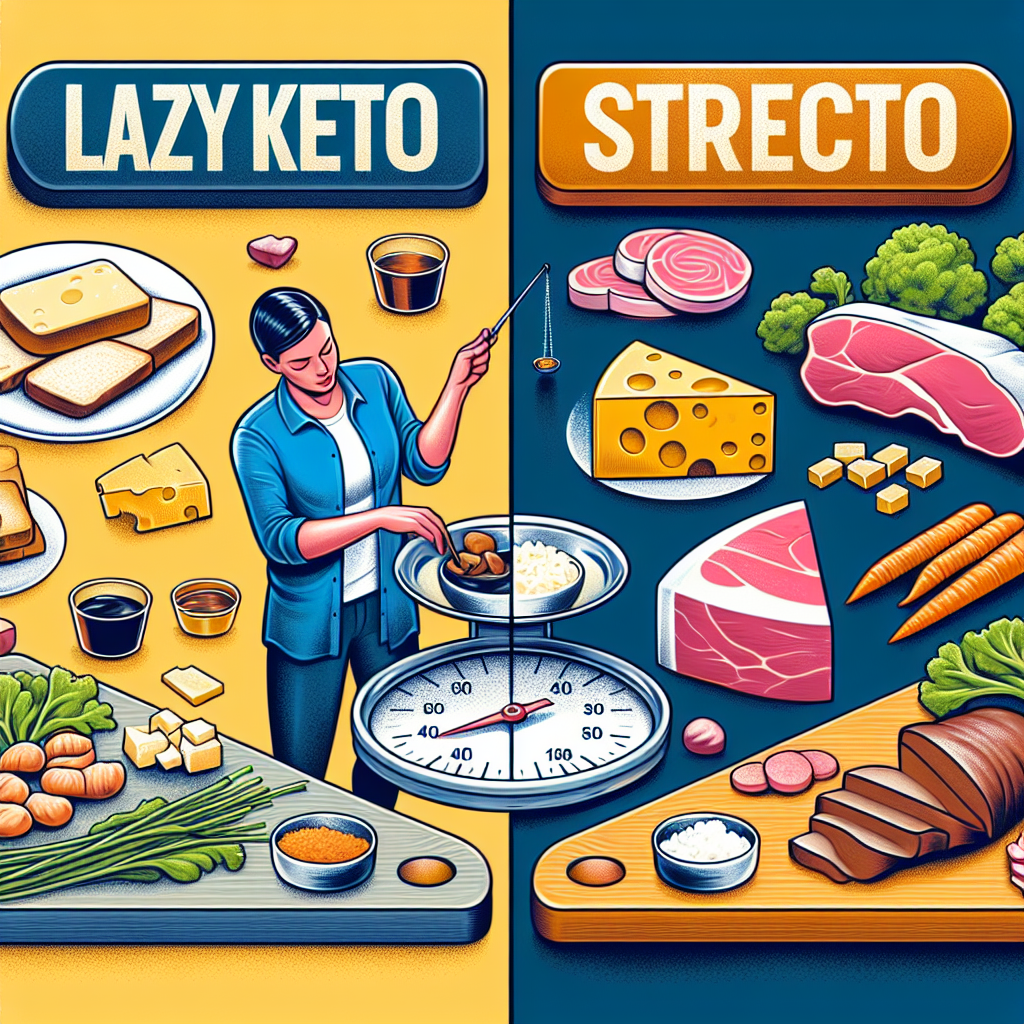
Lazy Keto vs. Strict Keto: Which Approach Actually Delivers Long-Term Results?
The ketogenic diet remains a popular choice for individuals seeking improved wellness and fat loss. Millions have adopted various forms of low-carb, high-fat keto plans to lose weight and support metabolic health. Among the most common styles are Lazy Keto and Strict Keto—each with its own rules, benefits, and potential pitfalls.
Although both aim to trigger ketosis—a metabolic state where fat becomes the body’s main energy source—the journey to get there can look very different. So, which plan sets you up for success in the long run without overwhelming your lifestyle?
Let’s dive into the details.
Understanding Lazy Keto
Lazy Keto offers a beginner-friendly, flexible path into ketogenic living. The key rule? Limit your daily net carbohydrates to around 20 grams. Unlike Strict Keto, you don’t track protein, fat, or total calorie intake. Instead, you simply avoid high-carb foods like bread, pasta, sugary drinks, and rice.
Real-life example: A Lazy Keto follower might have eggs and bacon for breakfast, a bunless burger for lunch, and steak with broccoli for dinner—without measuring or logging anything beyond carbs.
Benefits of Lazy Keto
– Less time-consuming and logistically simple
– Encouraging for keto beginners or those easing into a low-carb lifestyle
– Easier to maintain in social or busy settings
Drawbacks of Lazy Keto
– Limited nutrient control due to lack of fat and protein tracking
– Greater chance of hitting a weight-loss plateau by unknowingly exiting ketosis
– Not ideal for those with medical goals such as managing epilepsy or insulin sensitivity
A 2020 Nutrients study reported that people often underestimate their actual calorie intake by 15 to 30 percent when they don’t track consistently, affecting fat loss progress over time (Clark et al., 2020).
What Is Strict Keto?
Strict Keto, also known as Clean Keto or Tracking Keto, involves carefully measuring and managing your macronutrient intake. The typical ratio breaks down as follows:
– 70 to 75 percent fat
– 20 to 25 percent protein
– 5 to 10 percent carbohydrates
Strict Keto users often rely on tools like food scales and tracking apps to accurately follow keto-friendly macronutrient goals. This approach is typically chosen by individuals focused on optimizing results or managing chronic health conditions.
Example: A typical Strict Keto dinner might include a carefully measured 4 ounces of salmon, sautéed spinach in coconut oil, and exactly 25 grams of macadamia nuts.
Advantages of Strict Keto
– Promotes more consistent fat loss through accurate tracking
– Offers customizability for athletic performance or metabolic goals
– Supports therapeutic benefits for those with medical conditions
Challenges of Strict Keto
– Requires more mental and logistical effort, which can be draining over time
– Risk of “keto burnout” from rigid food tracking
– May be difficult to follow in social settings or during travel
According to Dr. Anna Richman, a registered dietitian and certified keto coach, “If your goal includes managing conditions like PCOS, epilepsy, or type 2 diabetes, the structure of Strict Keto offers the most reliable results.”
Lazy Keto vs. Strict Keto: Long-Term Success Compared
Weight Loss Results Over Time
Strict Keto is generally more effective for initial and long-term fat loss. By keeping carbohydrate intake low and aligning fat consumption with energy needs, metabolic efficiency improves. A 2022 review in Frontiers in Nutrition indicated that users on strict ketogenic protocols lost 2 to 3 times more weight at six months than those using more flexible, low-carb diets (Morrison et al., 2022).
On the other hand, Lazy Keto commonly shows rapid early results due to water loss from carbohydrate restriction. However, progress may plateau as the body receives inconsistent fat or protein intake and slips out of ketosis.
Sustainability and Lifestyle Compatibility
Lazy Keto tends to be easier to stick with over time. It reduces mental load, is more social-event friendly, and requires less time in the kitchen or on your phone. That makes it a better fit for many, especially those with busy routines or moderate goals.
Strict Keto requires dedication and precision, typically reserved for individuals aiming for measurable results, such as body recomposition, athletic enhancement, or managing chronic health issues.
Interestingly, a 2023 Keto-Mojo survey found that 64 percent of long-term keto adherents started with Lazy Keto before transitioning to Strict Keto as their needs and goals evolved.
Nutritional Balance and Food Quality
Strict Keto often has the upper hand when it comes to nutritional density. Since every bite is measured, users naturally pay more attention to nutrient-rich foods, leading to better intake of fiber, omega-3 fatty acids, and essential micronutrients.
Lazy Keto can sometimes drift into “dirty keto” territory—meaning choices are based solely on carb content rather than overall health value. Common examples include processed meats, excess cheese, and snack-friendly fats like pork rinds.
Regardless of which approach you follow, choosing whole foods—such as avocados, olive oil, leafy greens, and grass-fed meats—will support both your macro goals and your long-term health.
Transitioning Between Lazy and Strict Keto
If you’ve reached a weight-loss plateau or feel stalled on Lazy Keto, transitioning to elements of Strict Keto—even temporarily—can be a helpful reset.
You don’t need to track obsessively forever. Consider a short-term plan to measure macronutrients for a few weeks to get your progress back on track, then return to a more relaxed rhythm.
Which Keto Approach is Right for You?
The ideal keto plan is the one you can maintain consistently and without stress. Here’s a quick breakdown:
Choose Lazy Keto if you:
– Are new to keto or low-carb eating
– Prefer a low-maintenance plan
– Want flexible weight loss with fewer restrictions
Choose Strict Keto if you:
– Have a health condition or specific goal in mind
– Want to accelerate fat loss or body recomposition
– Feel confident in food tracking and planning
Dr. Evan Carter, a metabolic health expert, notes, “The diets that deliver long-term results are the ones people can actually follow for six months or more. Lazy Keto provides an easier entry point, while Strict Keto helps achieve precision-based goals.”
Supporting Your Keto Journey with Additional Resources
No matter which route you choose, supplementing your keto plan with reliable lifestyle tools can improve success. Explore health resources and weight loss support products through edrugstore.com to help ease the transition—especially when shifting between keto styles or managing common side effects like keto flu.
Final Thoughts on Keto Success
When evaluating Lazy Keto vs. Strict Keto for long-term health and fat loss, it’s clear both approaches have merit. The real differentiator isn’t how many carbs you eat—it’s how consistently you stick with your plan.
Lazy Keto offers a manageable lifestyle fit and a stepping stone into ketosis, while Strict Keto maximizes results through structure and precision.
Choose the format that aligns with your goals, routine, and personality. Either way, prioritize nutrient-rich foods, stay hydrated, and monitor your body’s response as you go. Your version of keto success is just a few consistent steps away.
References
– Clark M, et al. (2020). Dietary Tracking Accuracy in Weight Management: A Meta-Analysis. Nutrients. https://doi.org/10.3390/nu12123456
– Morrison S, et al. (2022). Ketogenic Diets and Long-Term Weight Loss: Evidence from Controlled Trials. Frontiers in Nutrition. https://www.frontiersin.org/articles/10.3389/fnut.2022.965432
– Keto-Mojo Survey Report. (2023). Trends in Long-Term Keto Success. https://keto-mojo.com/blog/keto-survey-results
– Dr. Anna Richman, RD. (2021). Interview on therapeutic applications of ketogenic diets. Ketogenic Practitioner Network.
– Dr. Evan Carter, MD. (2023). Commentary on dietary adherence and chronic disease management. Healthy Metabolics Quarterly.


